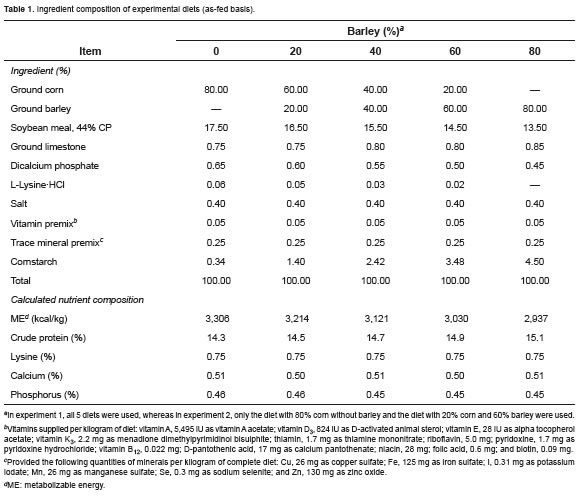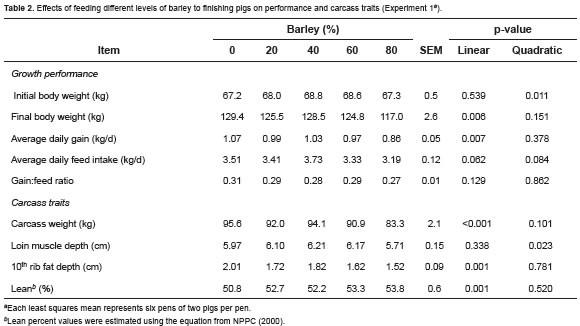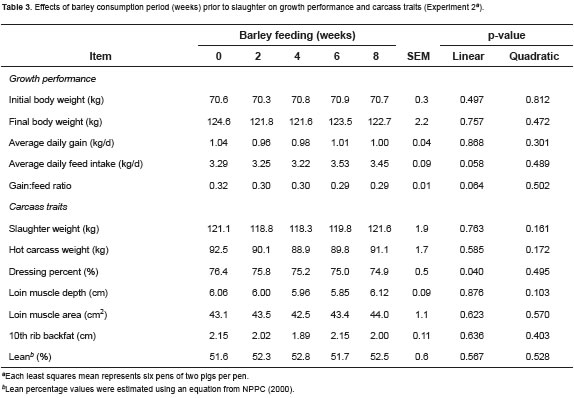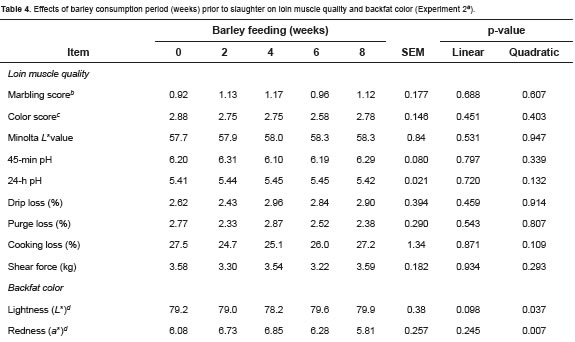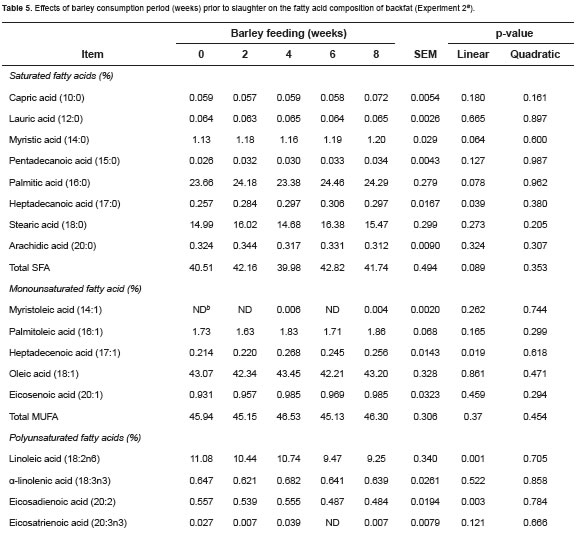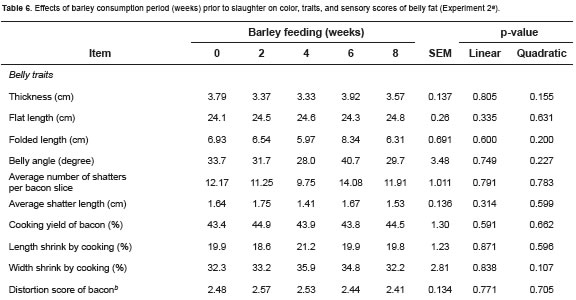Services on Demand
Journal
Article
Indicators
-
 Cited by SciELO
Cited by SciELO -
 Access statistics
Access statistics
Related links
-
 Cited by Google
Cited by Google -
 Similars in
SciELO
Similars in
SciELO -
 Similars in Google
Similars in Google
Share
Revista Colombiana de Ciencias Pecuarias
Print version ISSN 0120-0690
Rev Colom Cienc Pecua vol.27 no.2 Medellín Apri./June 2014
ORIGINAL ARTICLES
Effects of dietary barley on growth performance, carcass traits and pork quality of finishing pigs¤
Efecto de la inclusión dietaria de cebada sobre el crecimiento, calidad de la canal y de la carne de cerdos en engorde
Efeito da inclusão de cevada no crescimento, qualidade da carcaça e da carne de suínos em engorda
Beob G Kim1**, PhD; Duane M Wulf1, PhD; Robert J Maddock2, PhD; Dean N Peters2, MS; Carsten Pedersen2, PhD; Yanhong Liu1, PhD; Hans H Stein1*, PhD.
* Corresponding author: Hans H Stein. Department of Animal Sciences, University of Illinois, Urbana 61801, IL, USA. Tel +1 2173336462. Email: hstein@illinois.edu
** Current address: Department of Animal Science and Technology, Konkuk University, Seoul 143-701, Republic of Korea.
1Department of Animal Sciences, University of Illinois, Urbana, IL 61801, USA.
2Department of Animal and Range Sciences, South Dakota State University, Brookings, SD57007, USA.
(Received: April 11, 2013; accepted: October 2, 2013)
Summary
Background: the relatively high concentration of polyunsaturated fatty acid in yellow corn may reduce the quality of pork fat, but feeding barley instead of yellow corn may increase pork quality. Objective: to determine the effects of feeding graded levels of barley on performance, carcass composition, and pork quality of finishing pigs. Methods: in experiment 1, diets containing 0, 20, 40, 60, or 80% barley were fed to pigs (initial BW: 67.9 kg) for 8 weeks. In experiment 2, a diet containing 60% barley was fed to pigs for 0, 2, 4, 6, or 8 weeks prior to slaughter. Results: feeding diets with increasing levels of barley resulted in a linear decrease in daily gain (p<0.01) and backfat thickness (p<0.01). Dressing percentage linearly decreased with length of barley feeding (p<0.05), but the concentration of saturated fatty acids in backfat increased (linear, p<0.05) the longer the barley diet was fed. Conclusion: there was no effect of barley on loin muscle quality and barley did not consistently change fat color or belly and bacon quality.
Key words: belly traits, fatty acid composition, growth rate, swine nutrition.
Resumen
Antecedentes: la relativamente alta concentración de ácidos grasos poliinsaturados presente en el maíz amarillo puede reducir la calidad de la grasa del cerdo. Alimentar con cebada en lugar de maíz amarillo podría mejorar la calidad de dicha carne. Objetivo: determinar los efectos del suministro de niveles incrementales de cebada sobre el rendimiento, composición de la canal y calidad de la carne de cerdos en ceba. Métodos: en el experimento 1 se suministraron dietas que contenían 0, 20, 40, 60, o 80% de cebada a cerdos en ceba (PV inicial: 67,9 kg) durante 8 semanas. En el experimento 2 se suministró una dieta con 60% de cebada a cerdos durante 0, 2, 4, 6, u 8 semanas antes del sacrificio. Resultados: el introducir mayores niveles de cebada en la dieta resultó en una disminución lineal de la ganancia diaria (p<0,01) y del espesor de la grasa dorsal (p<0,01). El porcentaje de rendimiento disminuyó linealmente con la duración del suministro de cebada (p<0,05), pero la concentración de ácidos grasos saturados en la grasa dorsal aumentó (lineal, p<0,05) a medida que se incrementó la duración del suministro de cebada. Conclusión: no hubo efecto de la cebada en la calidad del músculo del lomo. La cebada no cambió el color de la grasa ni la calidad del vientre o del tocino.
Palabras clave: calidad del vientre, composición de ácidos grasos, nutrición porcina, tasa de crecimiento.
Resumo
Antecedentes: a concentração relativamente elevada de ácidos gordurosos poli-insaturados presentes no milho amarelo pode reduzir a qualidade da gordura suína. Fornecendo cevada ao invés de milho amarelo poderia melhorar a qualidade da carne. Objetivo: determinar os efeitos de níveis crescentes de cevada sobre o desempenho, composição e qualidade da carne a da carcaça de suínos de engorda. Métodos: no primeiro experimento os suínos foram alimentados durante o período de engorda com dietas contendo 0, 20, 40, 60, ou 80% de cevada (PV inicial de 67,9 kg) durante oito semanas. No segundo experimento se subministrou uma dieta com 60% de cevada aos suínos durante 0, 2, 4, 6 ou 8 semanas antes do abate. Resultados: a introdução de maiores níveis de cevada na dieta resultou em uma redução linear do ganho de peso diário (p<0,01) e da espessura de toucinho (p<0,01). A porcentagem de rendimento no período de engorda diminuiu linearmente com a duração de fornecimento de cevada (p<0,05), mas a concentração de ácidos gordurosos saturados do bacon aumentou enquanto se incrementou a duração de fornecimento de cevada (linear, p<0,05). Conclusão: não houve efeito de cevada na qualidade do olho de lombo. A cevada não mudou a cor da gordura nem a qualidade da barriga e do bacon.
Palavras chave: qualidade do ventre, composição de ácidos graxos, taxa de crescimento, nutrição de suínos.
Introduction
Corn-based diets fed to finishing pigs may result in soft fat due to the high levels of unsaturated fatty acids in corn oil, and the carotenoids in corn may result in deposition of yellow fat in pigs (Carr et al., 2005; Madsen et al., 1992; NPPC, 2000). Yellow fat is undesirable by some customers in Asia. Feeding barley instead of yellow corn often results in whiter and firmer pork fat with reduced iodine values (Lampe et al., 2006; Opapeju et al., 2006; Ringkob, 2003) because of the low concentration of carotenoids and PUFA in barley. However, feeding barley may reduce pig growth performance due to the greater fiber and the lower energy concentration compared with corn. Inclusion of barley in diets fed to pigs is, therefore, a balance between obtaining a desirable fat quality and color, and maintaining the best possible growth performance. Thus, the optimum level of barley in diets fed to finishing pigs, and the length that this diet needs to be fed to improve pork fat color and quality, need to be determined.
Therefore, the hypothesis tested in the present experiments was that feeding barley to finishing pigs may improve pork quality but also negatively affect pig growth performance. The objective was to determine an optimum inclusion level of barley in finishing diets for pigs and the period that is necessary to feed barley to obtain a desired pork quality without impairing pig growth performance.
Materials and methods
General procedures
Two experiments were conducted using crossbred pigs (SP-1 sires × Line 13 dams; Ausgene, Gridley, IL). Protocols for both experiments were reviewed and approved by the Institutional Animal Care and Use Committee at South Dakota State University where the experiments were conducted. Pigs were housed in an environmentally controlled finishing building with temperatures maintained at 18° C. Each pen (1.2 × 2.4 m) was equipped with a feeder and a nipple drinker and had a fully slatted concrete floor. Pigs had unlimited access to feed and water.
Experiment 1
In an 8-week growth assay, a total of 60 pigs with an average initial body weight (BW) of 67.9 ± 5.52 kg were used. Animals were grouped by BW into six blocks and randomly assigned to five treatment groups with two pigs (one barrow and one gilt) per pen and six replicate pens per treatment group in a randomized complete block design. The control diet contained 80% corn, 17.5% soybean meal, and 0.34% corn starch (Table 1). Four additional diets were formulated by adding 20, 40, 60, or 80% barley to the control diet by replacing equal amounts of corn in the diets. The concentration of soybean meal was reduced and the concentration of cornstarch was increased as the concentration of barley in the diets was increased because of the greater concentration of digestible AA in barley than in corn (NRC, 1998). All diets were formulated to contain similar concentrations of crude protein and lysine. Vitamins and minerals were added to meet or exceed requirement estimates for finishing pigs (NRC, 1998). Response variables were pig performance and carcass traits.
Experiment 2
This experiment also lasted 8-weeks and was conducted to evaluate the effect of feeding diets containing 60% barley to finishing pigs for 0, 2, 4, 6, or 8 weeks prior to slaughter. Sixty pigs with an initial BW of 70.7 ± 2.86 kg were randomly allotted to five treatment groups with two pigs (one barrow and one gilt) per pen and six replicate pens per treatment group in a randomized complete block design based on initial BW. The control diet was based on corn and soybean meal and was similar to the control diet used in experiment 1. The barley diet was similar to the 60% barley diet used in experiment 1. For the first treatment group, the control diet was offered for 8 weeks; for the second group, the control diet was fed for 6 weeks followed by the barley diet for 2 weeks; for the third group, the control diet was fed for 4 weeks followed by the barley diet for 4 weeks; for the fourth group, the control diet was fed for 2 weeks followed by the barley diet for 6 weeks; and for the last treatment group, the barley diet was fed for the entire 8-week experimental period. Pigs were humanely slaughtered at the conclusion of the experiment. Response variables included growth performance, carcass traits, pork fat quality and color, and fatty acid composition of backfat.
Growth trials and carcass measurements
In both experiments, animal BW and feed disappearance were determined every other week. Average daily gain (ADG), average daily feed intake (ADFI), and gain:feed ratio (G:F) were calculated at the conclusion of the experiment. All pigs were slaughtered at the Meat Science Laboratory at South Dakota State University following an overnight fast. Pigs were electrically stunned and dressed using standard operating procedures. After recording hot carcass weights, carcasses were placed in a cooler at 4 °C. Dressing percentage was calculated by dividing the hot carcass weight by the live BW. Loin muscle depth and 10th rib fat depth were measured, and carcass lean percentage was calculated (NPPC, 2000).
Pork quality and belly traits
Subjective marbling and color scores of the loin muscle were determined in pigs from experiment 2 based on the standards suggested by NPPC (2000). Sampling procedures, pork quality measurements, and backfat color determination were similar to the procedures described by Stein et al. (2006). Hue angle was calculated in degrees as tan-1 (b*/a*), and saturation index was calculated as [(a*)2 + (b*)2]0.5 (Little, 1975).
Bellies were removed from the right side of every carcass at 24 h postmortem. Belly traits, belly fat color, and bacon quality traits were measured using the procedures described by Stein et al. (2006). Fatty acid concentration in backfat samples was analyzed according to the method described by Sukhija and Palmquist (1988).
Statistical analysis
Data were analyzed as a randomized complete block design using the Generalized Linear Model procedure of SAS (SAS Inst. Inc., Cary, NC), and the pen was the experimental unit. Orthogonal polynomials were used to determine linear and quadratic effects of treatments. In experiment 2, belly thickness was used as a covariate in the analysis for backfat composition, belly angle, color, traits, and sensory scores of belly fat. The alpha level used for determination of statistical significance was 0.05.
Results
Experiment 1
Substitution of corn with barley resulted in a linear decrease (p<0.01) in ADG (Table 2). Feed intake also tended to decrease (linear, p=0.06) with increasing levels of dietary barley, but G:F was unaffected by the levels of dietary barley. Carcass weights linearly decreased (p<0.001) and loin muscle depth was reduced (quadratic, p<0.05) with increasing levels of barley in the diets. Increasing levels of barley in the diet also resulted in thinner backfat (linear, p<0.01) and greater carcass lean percentage (linear, p<0.01) compared with pigs fed diets containing more corn and less barley.
Experiment 2
Pigs tended to consume more feed (linear, p=0.06) and to have less G:F (linear, p=0.06) the longer the barley diet was fed, but there was no effect of barley on ADG (Table 3). The dressing percentage linearly decreased (p<0.05) with increasing time of feeding barley, but all other carcass traits were unaffected by feeding the barley diet.
Loin muscle marbling, color, pH, drip loss, and shear force were not affected by feeding the barley diet (Table 4). However, lightness of backfat increased (quadratic, p<0.05) and redness decreased (quadratic, p<0.01) with increasing time of feeding the barley diet. Hue angle was the least and saturation index was the greatest in pigs fed the barley diet for 4 weeks (quadratic, p<0.05).

Total saturated fatty acids (SFA) tended to increase (linear, p=0.09) whereas total polyunsaturated fatty acids (PUFA) decreased (linear, p<0.01) with increasing time of feeding the barley diet (Table 5). Longer periods of feeding the barley diet prior to slaughter also resulted in linear decreases (p<0.01) in total n-6 fatty acids, n-6:n-3 ratio, PUFA:SFA ratio, and calculated iodine value. Bacon quality criteria -including physical traits, color, and sensory traits- were not influenced by feeding the barley diet (Table 6).
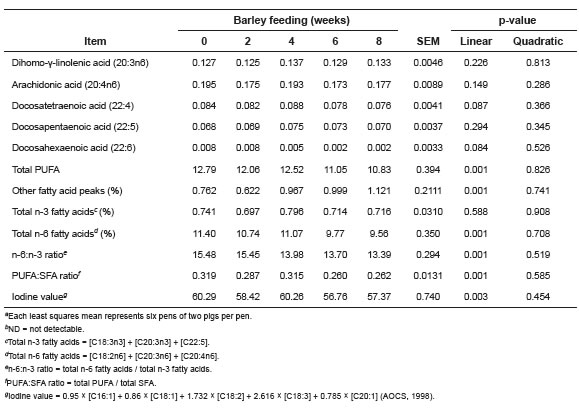
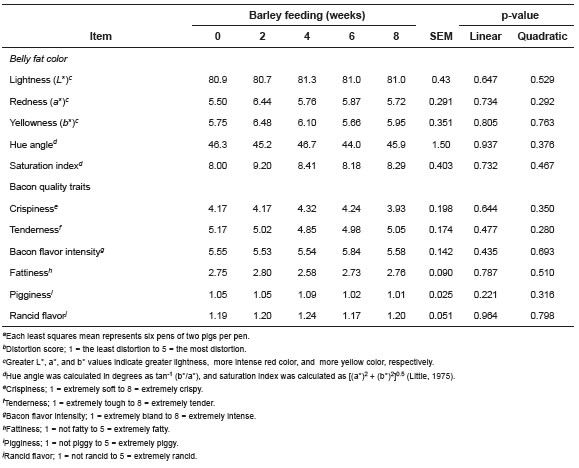
Discussion
Pigs fed corn-based diets may produce darker fat than pigs fed barley-based diets because of the relatively high levels of carotenoids in corn. The high levels of PUFA in corn may also result in pigs depositing more soft fat if they are fed corn-based diets than if they are fed barley-based diets (Carr et al., 2005; NPPC, 2000). Thus, feeding a barleybased diet may solve these fat quality issues because barley contains lower levels of carotenoids and less PUFA than corn. However, feeding barley may reduce growth performance because of the high fiber content. It is, therefore, important to determine the inclusion level of barley in diets fed to finishing pigs that is needed to improve pork quality without negatively impacting growth performance.
The reduction of growth performance observed in experiment 1 as the inclusion level of barley increased is in agreement with data from McConnell et al. (1975) who reported that pigs fed barley-based diets gained weight more slowly and less efficiently than those fed corn-based diets. Chung et al. (1998) reported decreased ADG during the early finishing period (52 to 86 kg BW), but not during the late finishing period (86 to 104 kg BW) if 36% of corn was replaced with barley. However, more recent experiments indicated that feeding barley instead of corn resulted in only numerical reductions of weight gain (Carr et al., 2005; Opapeju et al., 2006). Inclusion levels of barley and consumption period may influence growth performance. It is also possible that barley variety and its growing conditions influence the outcome because these factors may impact its nutritional composition, considering that relatively large variability in the nutritional value of barley has been reported (Castell and Bowren, 1980; Fairbairn et al., 1999).
The reduced backfat depth in pigs fed barley-based diets observed in experiment 1 agrees with data by McConnell et al. (1975). The reason for this reduction is most likely that pigs do not increase feed intake sufficiently to compensate for the reduced energy concentration in the barley-based diets, which results in the barley-fed pigs consuming less energy than the corn-fed pigs. The reduced energy intake in pigs fed the barley-based diets resulted in less backfat deposited. However, results of previous experiments indicated that inclusion of barley in the diets instead of corn resulted in no change in backfat depth (Carr et al., 2005; Lawrence, 1977; Opapeju et al., 2006). The energy concentration also varies among varieties of barley (Fairbairn et al., 1999), which may be the reason for the different responses to barley inclusion in the diets. However, the fact that no changes in muscle depth were observed for pigs fed diets containing 20, 40, or 60% barley indicate that dietary amino acids did not limit protein synthesis. The reduction in loin depth in pigs fed the diet containing 80% barley may be a result of pigs deaminating some of the dietary amino acids for ATP synthesis because of the reduced energy intake in these pigs compared with pigs fed the diet with no barley.
Based on the results of experiment 1, it was concluded that 60% barley in the diets resulted in acceptable pig performance and this level of barley was, therefore, used in the barley diet that was prepared for experiment 2. The fact that pig growth performance was not impacted by the inclusion of barley in the diets in experiment 2 confirmed that the diet with 60% barley was adequate to support pig performance.
The reduction of dressing percentage that was observed as pigs were fed barley is likely a result of the greater fiber concentration in barley compared with corn because increased concentrations of dietary fiber usually results in a reduced dressing percentage (Kass et al., 1980). The observation that loin muscle quality was not affected by inclusion of barley in the diets is in agreement with previous data (Carr et al., 2005; Lampe et al., 2006; McConnell et al., 1975) and indicates that the quality of the loin is not compromised if pigs are fed diets based on barley rather than corn.
It was, however, expected that the color of backfat would be less yellow as barley was included in the diets because of the low concentration of carotenoids in barley compared with corn. Feeding a barley-based diet has been reported to result in whiter and less yellow backfat (Ringkob, 2003), but results of this experiment did not support the result of Ringkob (2003) because the yellowness of the backfat was unaffected by inclusion of barley in the diet and only small changes in lightness and redness were observed. The results obtained in this experiment, therefore, support the data reported from other experiments in which pork fat color was also not changed as barley was introduced in the diets (Carr et al., 2005; Lampe et al., 2006). It is not clear why different results have been obtained in terms of the consequence for pork fat of feeding barley-based diets, but it is possible that there are differences among varieties of barley in their ability to influence pork fat color. Nevertheless, results of this experiment and of other recent experiments indicate that inclusion of barley in diets fed to finishing pigs is not an effective procedure to change the color of pork fat and thereby, produce pork with a whiter and more desirable color.
The fatty acid composition of pork fat is influenced by the fatty acid composition of the lipids in the diet (Apple et al., 2007; Averette et al., 2002; Weber et al., 2006). The increased concentrations of SFA, the reduced concentrations of PUFA, and the reduced PUFA:SFA ratio that were observed in the present experiment as barley was included in the diet were, therefore, expected and likely reflect the differences in fatty acid composition between fat in barley and fat in corn. The depression in the concentration of total n-6 fatty acids, the n-6:n-3 ratio, and the calculated iodine values as barley was included in the diets for longer periods of time also reflect differences in fatty acid composition between the fat in barley and the fat in corn. The lowered iodine values in pigs fed the barley diet indicate that more desirable and firmer fat is deposited if pigs are fed barley instead of corn. These observations are in agreement with data indicating that feeding barley results in increased saturation of backfat and reduced iodine values compared with feeding corn (Lampe et al., 2006; Opapeju et al., 2006). Based on the data for PUFA and iodine values, it is concluded that feeding a diet containing 60% barley for 6 weeks prior to slaughter most efficiently modifies PUFA and saturation of backfat compared with other feeding periods.
The PUFA concentrations in backfat (less than 13%) for all treatments indicates that regardless of the dietary treatment used in this experiment, the concentration of PUFA was acceptable for salami production (Warnants et al., 1998). Although fatty acids of belly fat were not determined in the present study, the concentrations of linoleic acid and PUFA in belly fat were likely within the recommended ranges of 14 and 15%, respectively (NPPC, 2000), because concentrations of linoleic acid and PUFA are less in belly fat than in backfat (Opapeju et al., 2006). The iodine values in the present experiment were also less than the upper limit (e.g. less than 70 to 73) for desirable fat (Lea et al., 1970; Madsen et al., 1992). Thus, although expanded periods of feeding barley improve backfat quality, the backfat from pigs fed no barley had adequate quality to meet current quality standards. However, if feed ingredients with greater concentrations of unsaturated fatty acids are used, backfat with iodine values greater than the desirable levels are often observed (Benz et al., 2010; Xu et al., 2010). Under such circumstances, inclusion of barley in the diets rather than corn may help ameliorate the negative impact of using ingredients with unsaturated fatty acids in the diets.
The fact that bacon quality was not influenced by inclusion of barley in the diets indicates that consumers would not be able to tell if bacon is produced from pigs fed corn- or barley-based diets. We are not aware of other experiments in which the influence of feeding barley on the quality of bacon has been reported.
In conclusion, as the level of dietary barley increased, weight gain was depressed, backfat thickness was decreased, and lean percentage was increased. However, pigs fed diets containing barley did not have whiter backfat or bacon fat, which indicates that inclusion of barley in the diet is not an effective way of changing the color of pork fat. Nevertheless, inclusion of 60% barely in the diets at the expense of corn resulted in acceptable animal performance and improved pork fat quality. The improved pork fat quality can be obtained if the diet containing 60% barley is provided for 6 weeks prior to slaughter.
¤ To cite this article: Kim BG,Wulf DM, Maddock RJ, Peters DN, Pedersen C, Liu Y, Stein HH. Effects of dietary barley on growth performance, carcass traits and pork quality of finishing pigs. Rev Colomb Cienc Pecu 2014; 27:102-113.
References
AOCS, American Oil Chemist's Society. Official methods and recommended practices of the AOCS. 5th ed. Recommended practice Cd 1c-85. Champaign, IL: American Oil Chemist's Society; 1998. [ Links ]
Apple JK, Maxwell CV, Sawyer JT, Kutz BR, Rakes LK, Davis ME, Armstrong TA. Interactive effect of ractopamine and dietary fat source on quality characteristics of fresh pork bellies. J Anim Sci 2007; 85:2682-2690. [ Links ]
Averette GL, See MT, Hansen JA, Sutton D, Odle J. The effects of dietary fat sources, levels and feeding intervals on pork fatty acid composition. J Anim Sci 2002; 80:1606-1615. [ Links ]
Benz JM, Linneen SK, Tokach MD, Dritz SS, Nelssen JL, DeRouchey JM, Goodband RD, Sulabo RC, Prusa KJ. Effects of dried distillers grains with solubles on carcass fat quality of finishing pigs. J Anim Sci 2010; 88:3666-3682. [ Links ]
Carr SN, Rincker PJ, Killefer J, Baker DH, Ellis M, McKeith FK. Effects of different cereal grains and ractopamine hydrochloride on performance, carcass characteristics, and fat quality in latefinishing pigs. J Anim Sci 2005; 83:223-230. [ Links ]
Castell AG, Bowren KE. Comparison of barley cultivars in diets for growing-finishing pigs. Can J Anim Sci 1980; 60:159-167. [ Links ]
Chung YK, Chae BJ, KimJH, ChuKS, Han IK. An evaluation of barley in finisher pig diet for high quality pork production. Korean J Anim Nutr Feedstuff 1998; 22:15-20. [ Links ]
Fairbairn SL, Patience JF, Classen HL, Zijlstra RT. The energy content of barley fed to growing pigs: Characterizing the nature of its variability and developing prediction equations for its estimation. J Anim Sci 1999; 77:1502-1512. [ Links ]
Kass ML, VanSoest PJ, Pond WG, Lewis B, McDowell RE. Utilization of dietary fiber from alfalfa by growing swine. I. apparent digestibility of diet components in specific segments of the gastrointestinal tract. J Anim Sci 1980; 50:175-191. [ Links ]
Lampe JF, BaasTJ, Mabry JW. Comparison of grain sources for swine diets and their effect on meat and fat quality traits. J Anim Sci 2006; 84:1022-1029. [ Links ]
Lawrence TLJ. Some effects on the growth and composition of the carcass of the bacon pig of feeding micronized or ground maize or barley based diets to give three different digestible energy intakes. Livest Prod Sci 1977; 4:343-353. [ Links ]
Lea CH, Swoboda PAT, Gatherum DP. A chemical study of soft fat in cross-bred pigs. J Agric Sci 1970; 74:279-289. [ Links ]
Little AC. Off on a tangent-colorimetry in food science. J Food Sci 1975; 40:410-411. [ Links ]
Madsen A, Jakobsen K, Mortensen HP. Influence of dietary fat on carcass fat quality in pigs. A review. Acta Agric Scand 1992; 42:220-225. [ Links ]
McConnell JC, Skelley GC, Handlin DL, Johnston WE. Corn, wheat, milo and barley with soybean meal or roasted soybeans and their effect on feedlot performance, carcass traits and pork acceptability. J Anim Sci 1975; 41:1021-1030. [ Links ]
NPPC, National Pork Producers Council. Pork composition and quality assessment procedures. Des Moines, IA: National Pork Producers Council; 2000. [ Links ]
NRC, National Research Council. Nutrient requirements of swine. 10th ed. Washington, D.C.: National Academy Press; 1998. [ Links ]
Opapeju FO, Nyachoti CM, House JD, Weiler H, Sapirstein HD. Growth performance and carcass characteristics of pigs fed shortseason corn hybrids. J Anim Sci 2006; 84:2779-2786. [ Links ]
Ringkob TP. Comparing pork fat color from barley and corn fed pork using image analysis. In Proceedings of the 56th Reciprocal Meat Conference, Columbia, MO. Savoy, IL: American Meat Science Association; 2003. [ Links ]
Stein HH, Everts AKR, Sweeter KK, Peters DN, Maddock RJ, Wulf DM, Pedersen C. The influence of dietary field peas (Pisum sativum L.) on pig performance, carcass quality, and the palatability of pork. J Anim Sci 2006; 84:3110-3117. [ Links ]
Sukhija PS, Palmquist DL. Rapid method for determination of total fatty acid content and composition of feedstuffs and feces. J Agric Food Chem 1988; 36:1202-1206. [ Links ]
Warnants N, Van Oeckel MJ, Boucqué ChV. Effect of incorporation of dietary polyunsaturated fatty acids in pork backfat on the quality of salami. Meat Sci 1998; 49:435-445. [ Links ]
Weber TE, Richert BT, Belury MA, Gu Y, Enright K, Schinckel AP. Evaluation of the effects of dietary fat, conjugated linoleic acid, andractopamine on growth performance, pork quality, and fatty acid profiles ingenetically lean gilts. J Anim Sci 2006; 84:720-732. [ Links ]
Xu G, Baidoo SK, Johnston LJ, Bibus D, Cannon JE, Shurson GC. Effects of feeding diets containing increasing content of corn distillers dried grains with solubles to grower-finisher pigs on growth performance, carcass composition, and pork fat quality. J Anim Sci 2010; 88:1398-1410. [ Links ]













